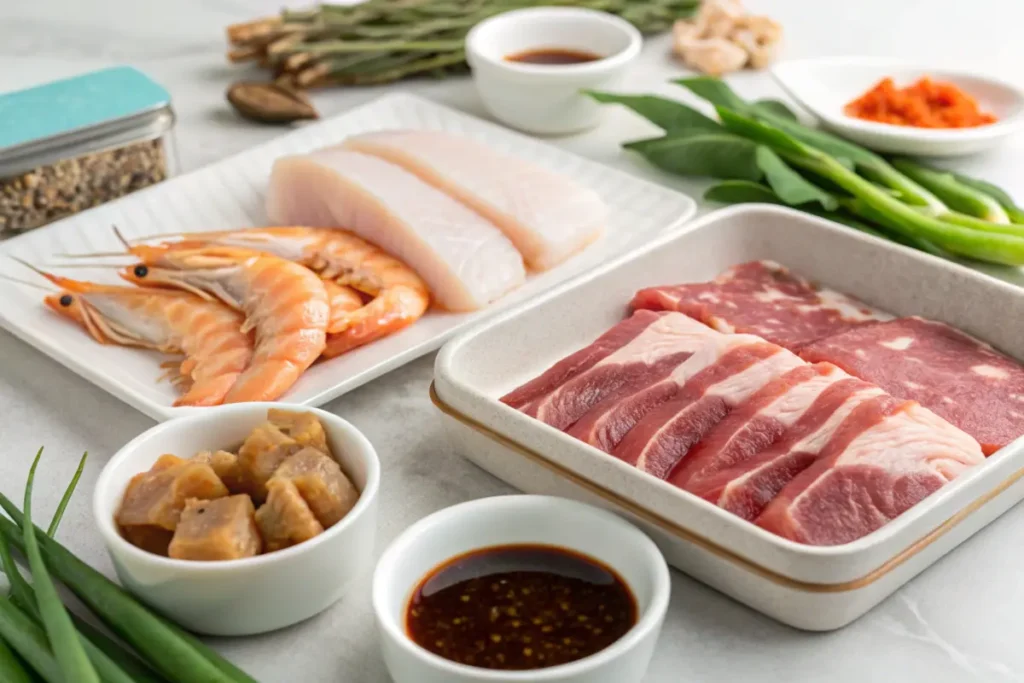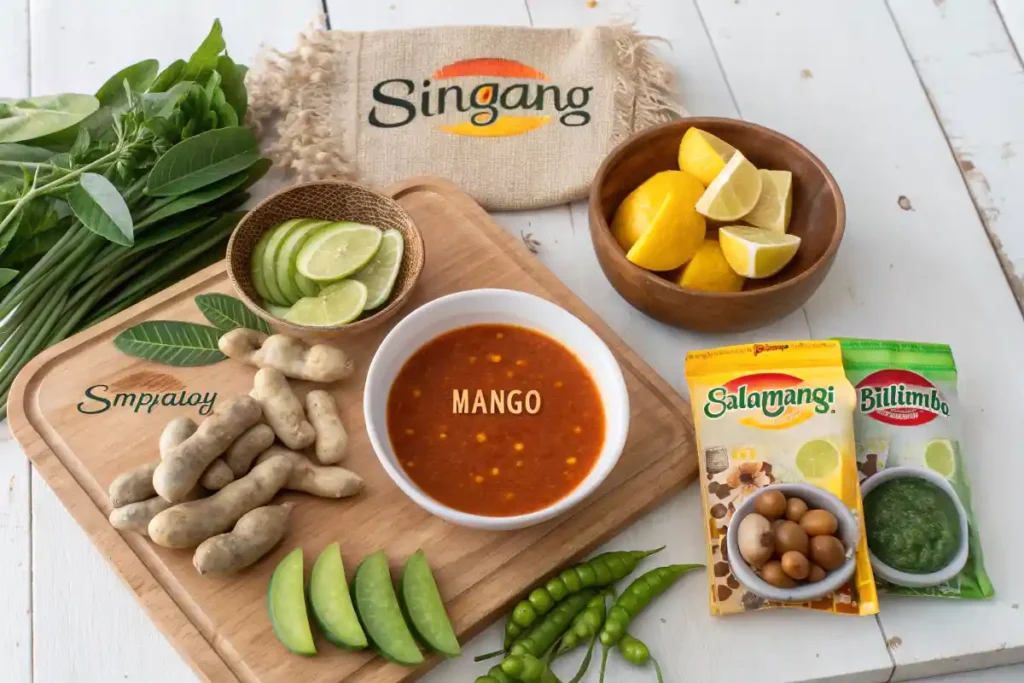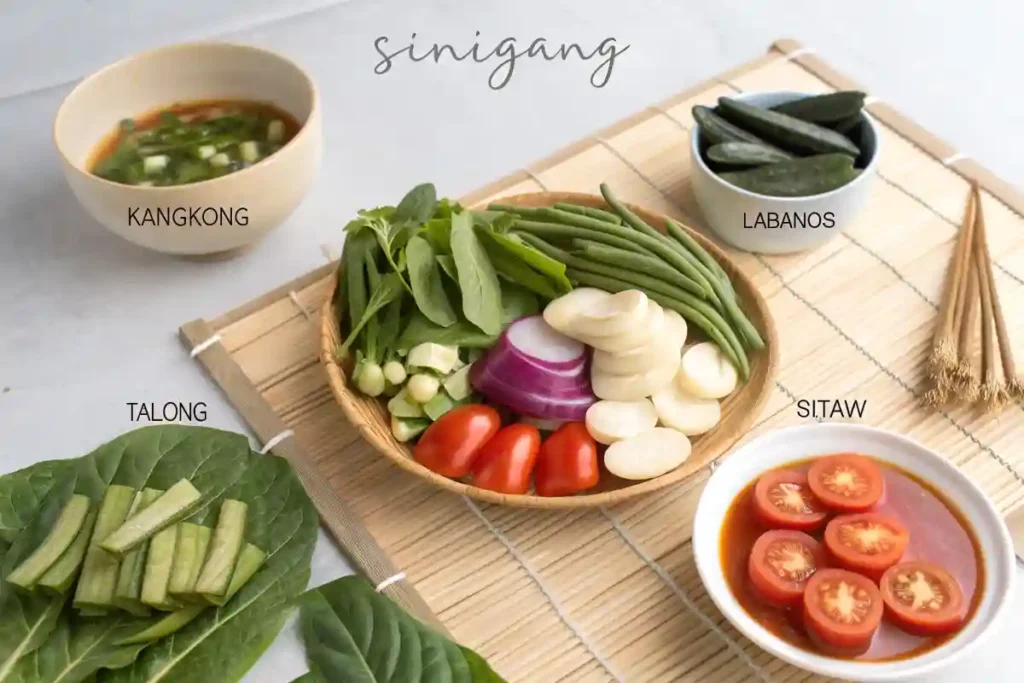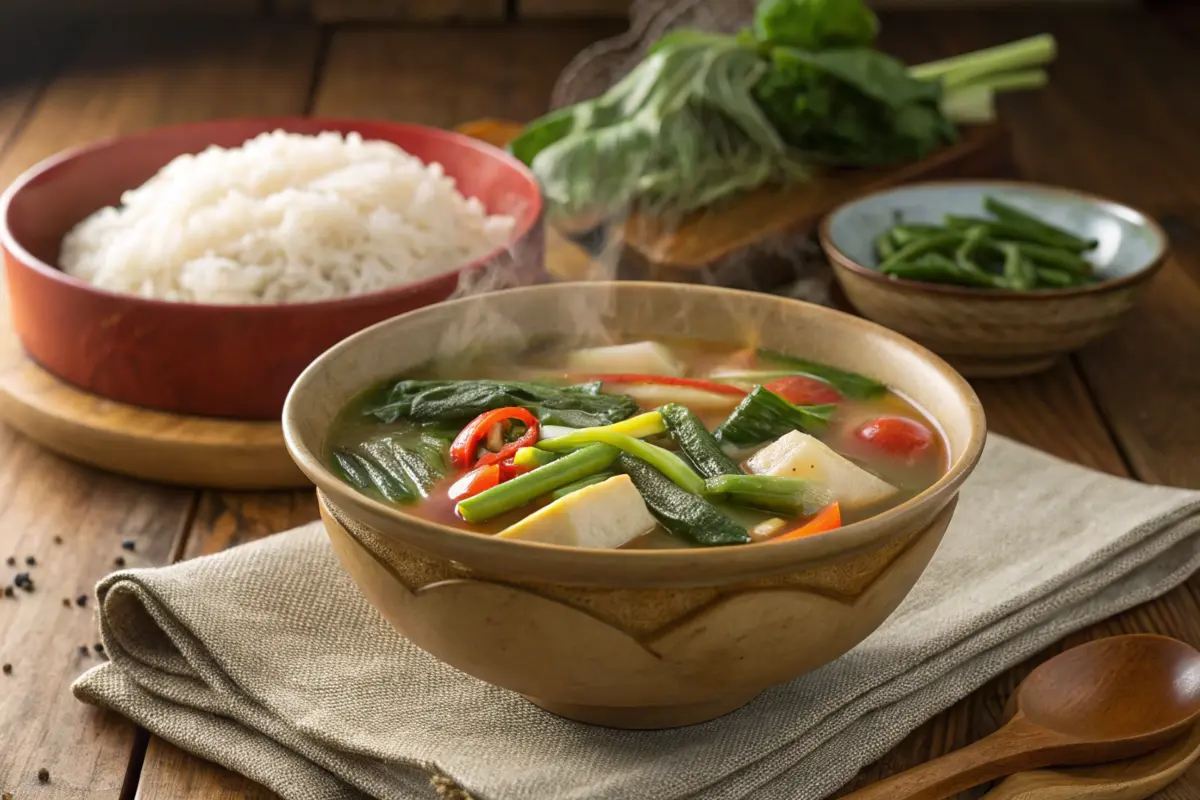Sinigang, a classic Filipino dish, is a delightful medley of flavors that marries the tangy, savory, and comforting all in one bowl. Often dubbed as the soul food of the Philippines, this sour soup is renowned for its versatility and cultural significance. Whether enjoyed during a family gathering or on a rainy day, Sinigang warms the heart and tickles the taste buds. In this article, we’ll explore what are the main ingredients of Sinigang and delve into the unique components that make it a culinary masterpiece.
Introduction to Sinigang
What is Sinigang?
Sinigang is more than just a dish—it’s a culinary heritage that reflects Filipino culture and ingenuity. This sour soup is characterized by its tangy broth, which derives its distinct flavor from natural souring agents like tamarind, guava, or green mango. Traditionally served with rice, it embodies the perfect harmony of salty, sour, and savory.
Unlike other soups, Sinigang stands out for its adaptability. From pork belly to shrimp or fish, it allows endless customization based on regional ingredients or personal preferences. This adaptability is a testament to its role as a staple in Filipino households.
Variations of Sinigang
While pork Sinigang is arguably the most popular variant, other proteins such as beef, chicken, and seafood also shine in this dish. For instance, Sinigang na Hipon features plump shrimp simmered in the signature tangy broth, offering a lighter yet equally flavorful experience. Regional variations also bring unique twists—some regions incorporate guava for a fruity tang, while others prefer a thicker soup with taro.
What makes Sinigang truly special is its ability to evolve with the times. From traditional recipes to modern shortcuts like instant Sinigang mix, it has found a way to remain a beloved dish across generations.
Sinigang’s legacy isn’t just about its taste—it’s about its ability to bring people together, showcasing the warmth and hospitality that Filipinos are known for. Next, we’ll dive into the protein ingredients that serve as the backbone of this iconic dish.
Key Protein Ingredients in Sinigang

Primary Protein Options
When it comes to what are the main ingredients of sinigang, the protein is undoubtedly a cornerstone. Traditionally, pork belly takes center stage. Known for its balance of fat and meat, pork belly delivers a melt-in-your-mouth tenderness while enriching the broth with depth and flavor. Cuts like spare ribs or pork shoulder are also popular, offering variations in texture and taste.
However, Sinigang isn’t limited to pork. Other common options include shrimp (Sinigang na Hipon), which adds a delicate seafood sweetness, and beef, often preferred for its hearty and robust character. Chicken and fish, particularly milkfish (bangus), are lighter alternatives for those seeking a leaner protein base.
Selecting the Right Meat or Seafood
Choosing the right protein isn’t just about flavor; it also influences cooking techniques. For instance, tougher cuts of beef require slow simmering to achieve tenderness, while shrimp needs only a few minutes to cook to perfection. These nuances are why Sinigang is such a versatile dish—it adapts seamlessly to the cook’s preference and the available ingredients.
No matter the protein, the process always involves letting the meat or seafood soak in the sour broth, allowing it to absorb the tangy flavors fully. This interaction is what makes each bite a delightful mix of tender meat and vibrant soup.
(Pro tip: Check out this authentic Sinigang recipe guide for more details on traditional methods and tips!)
Essential Sour Ingredients

Traditional Sour Agents
The soul of Sinigang lies in its sour broth, a defining characteristic that sets it apart from other soups. The most traditional ingredient is young tamarind (sampaloc), prized for its rich, tangy flavor. Tamarind is boiled until soft, then mashed to extract its juice, which becomes the foundation of the soup.
Other regional souring agents include guava, which adds a subtly sweet tang; kamias (bilimbi), known for its intense sourness; and green mango, offering a unique fruity sharpness. Each ingredient imparts a slightly different flavor, allowing for endless personalization.
Modern Shortcuts: Sinigang Mix
In today’s busy kitchens, instant Sinigang mix has become a convenient alternative. While it simplifies the preparation process, purists argue that it lacks the complexity of flavors derived from fresh ingredients. Still, it’s a handy option when you’re pressed for time and craving the familiar taste of this Filipino classic.
The sourness of the broth is what makes people ask for more, as it awakens the taste buds and brings all the other flavors together. Whether you stick to tradition or take the modern route, the sour component ensures that every bowl of Sinigang is a burst of flavor and comfort.
Vegetables in Sinigang

Core Vegetables
One of the standout features of Sinigang is its medley of vibrant vegetables, which not only add nutrition but also elevate its flavor and texture. What are the main ingredients of sinigang if not the fresh and earthy vegetables? A quintessential choice is water spinach (kangkong), whose tender leaves and stems soak up the sour broth beautifully.
String beans (sitaw), sliced into manageable lengths, provide a satisfying crunch, while eggplant, cut diagonally or roll-cut, absorbs the tangy essence of the soup. Daikon radish (labanos) is another classic addition, offering a subtly sweet and slightly peppery taste that balances the dish.
Supporting Vegetables
Beyond the essentials, other vegetables help round out the dish. Tomatoes are often added early in the cooking process to deepen the broth’s flavor. Okra, with its slightly slimy texture, enhances the richness of the soup, and long green peppers bring a hint of mild heat.
Depending on availability or personal preference, some cooks include taro (gabi) to thicken the broth, or bok choy as a substitute for water spinach. The flexibility of Sinigang makes it a dish that adapts beautifully to whatever vegetables are on hand.
If you’re looking for more inspiration to diversify your Sinigang recipe, check out our Sinigang recipe guide for tips and variations.
Complementary Flavors and Condiments
Fish Sauce
No Sinigang is complete without fish sauce (patis), which serves as the ultimate umami booster. A dash of this savory condiment adds depth and enhances the dish’s overall flavor. It’s often used both during cooking and as a dipping sauce on the side, making each bite irresistible.
Spices and Herbs
While the sourness dominates, subtle seasoning completes the dish. Ground black pepper, although optional, adds a gentle kick. In some regional versions, herbs like lemongrass or cilantro may be included to add aroma and complexity.
Pairing for the Perfect Meal
Sinigang is best served hot with steamed rice, which helps balance its tangy and savory notes. For an extra layer of flavor, pair it with a side dish like fried fish or crispy pork. This combination creates a hearty, comforting meal that highlights the versatility of Sinigang.
For more delicious Filipino dishes that pair well with Sinigang, visit our website and explore creative recipe ideas!
Cooking Process and Tips
Step-by-Step Preparation
Preparing Sinigang is as simple as it is rewarding. To begin, the souring agent is prepped first—whether it’s fresh tamarind or an instant mix. For traditional methods, young tamarind is boiled until soft, then mashed to extract its sour juices. This step lays the foundation for the tangy broth.
Next, the meat or seafood is simmered in the prepared broth along with onions and tomatoes to create a rich, flavorful base. The trick is to let the proteins cook slowly, allowing them to absorb the sour flavors fully.
Vegetables are added sequentially, starting with those that take longer to cook, such as daikon radish or eggplant, followed by more delicate ones like okra and water spinach. This method ensures every ingredient is perfectly tender without becoming overcooked.
Cooking Hacks for Busy People
For those short on time, modern appliances like slow cookers or Instant Pots can streamline the process. Toss in all the ingredients except the leafy greens, and let the device handle the work. Add the water spinach or other greens just before serving to keep them fresh and vibrant.
Another time-saving tip is using instant Sinigang mix, which simplifies the broth preparation. While purists may prefer fresh souring agents, the convenience of ready-made options ensures you can enjoy Sinigang even on busy days.
By following these simple steps, you’ll master the art of Sinigang, ensuring every bowl is bursting with flavor.
Frequently Asked Questions (FAQs)
Why is Sinigang Considered a Filipino Staple?
Sinigang is celebrated not just for its taste but also for its cultural significance. It reflects the Filipino preference for bold, tangy flavors and the use of fresh, local ingredients. Whether it’s pork, shrimp, or fish, every family has its unique take on the dish, making it a beloved staple across generations.
Can Sinigang Be Made Vegetarian?
Yes! A vegetarian version of Sinigang swaps the meat for plant-based proteins like tofu and incorporates a wider variety of vegetables, such as bok choy and mushrooms. The tangy broth, made with tamarind or kamias, remains the heart of the dish, ensuring it retains its iconic flavor.
What Are the Health Benefits of Sinigang?
Sinigang is not only delicious but also packed with nutrients. Its mix of vegetables provides vitamins and minerals, while the broth is low in fat and calories. The sour agents, like tamarind and guava, are rich in antioxidants, making this dish as nourishing as it is flavorful.
How Do You Perfect the Flavor of Sinigang?
Balancing the sour, savory, and salty flavors is key. Start with a little fish sauce, taste as you go, and adjust the sourness by adding more tamarind or Sinigang mix. Remember, fresh ingredients always elevate the dish, so choose the best produce and proteins available.
For additional tips on Filipino cooking, visit our website and explore more classic recipes! Let me know when you’re ready for the conclusion.
Conclusion
Why Sinigang Stands Out
Sinigang is more than just a meal; it’s a celebration of Filipino culture and culinary traditions. By blending tangy, savory, and earthy flavors, it delivers a comforting yet vibrant experience in every bowl. From its flexible protein options to its wide array of vegetables, it adapts to personal tastes and available ingredients, making it an incredibly versatile dish.
When considering what are the main ingredients of sinigang, the answer lies not only in the components themselves but also in the love and effort put into preparing it. Whether made with pork, shrimp, or a vegetarian twist, each version carries the same soul-warming essence that has endeared Sinigang to countless families around the world.
Sinigang is a dish that tells a story—of family gatherings, rainy afternoons, and shared memories. Its enduring popularity speaks to its ability to evolve while staying rooted in tradition. No matter where or how it’s served, Sinigang remains a beloved staple that transcends generations.
Call to Action and Further Exploration
Explore More Filipino Dishes
Now that we’ve answered what are the main ingredients of sinigang and explored the richness of this iconic soup, why not dive deeper into Filipino cuisine? The Philippines boasts a diverse culinary heritage, and there’s much more to discover beyond Sinigang. From adobo to lechon, every dish offers a unique glimpse into the country’s flavors and culture.
For more Filipino recipes and cooking inspiration, visit our website and explore a variety of guides and tips. Whether you’re a seasoned cook or just starting out, you’ll find plenty of ideas to bring the taste of the Philippines to your kitchen.
Feel free to let me know if you’d like to continue exploring Filipino cuisine or need further assistance with another topic!

